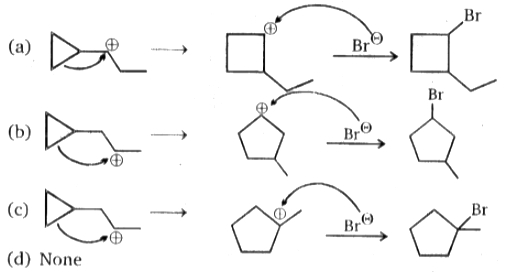On catalytic reduction by one mole H2/Pt ,how many alkenes will give n-butane?
(a)1
(b)2
(c)3
(d)4
(a)1
(b)2
(c)3
(d)4

1. \(\mathrm{CH}_3-\mathrm{CH}_3\)
2. \(\mathrm{CH}_2=\mathrm{CH}_2\)
3. \(\mathrm{CH}_3-\mathrm{CH}=\mathrm{CH}_2\)
4. None of the above.
Which of the following bromides is the major product of the reaction shown below, assuming that there are no carbocation rearrangement?
1.
2.
3.
4.
What is a likely product of the reaction shown?
1.
2.
3.
4.
Which of the following, when undergoing addition of HBr, will form ONLY a pair of diastereomers?
Taking into account the stability of various carbocations and, as well as the rules governing mechanisms of carbocation rearrangements, which reaction is most likely to occur during the given reaction ?


Which of the following is the best stereochemical representation when reaction between 1 -methylcyclohexene and NBS react in aqueous dimethyl sulfoxide?
| 1. |  |
2. |  |
| 3. |  |
4. | None of these |
= CH2(A); (A) is:
(a)
(b)
(c)
(d) CH3--CH2-CH=CH2
Di-imide (N2H2) is used to reduce double bond of:
(1)
(2)
(3) -NO2
(4) -CH=CH-

























